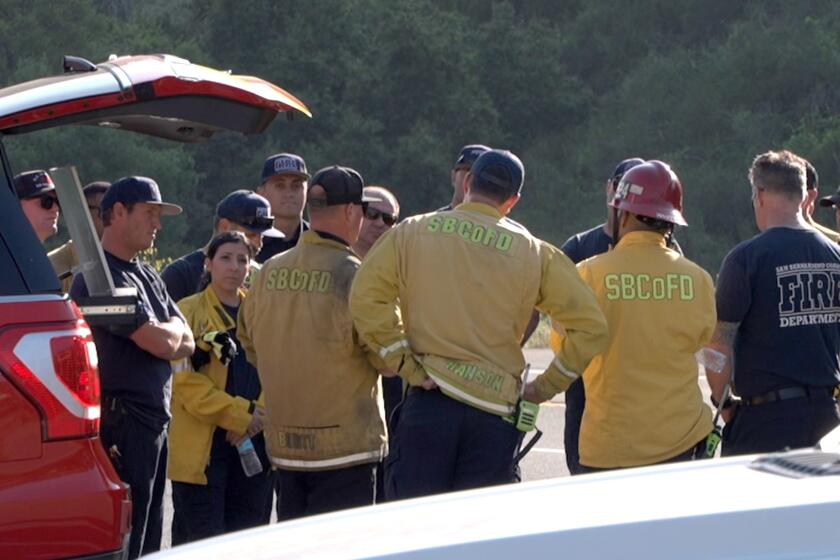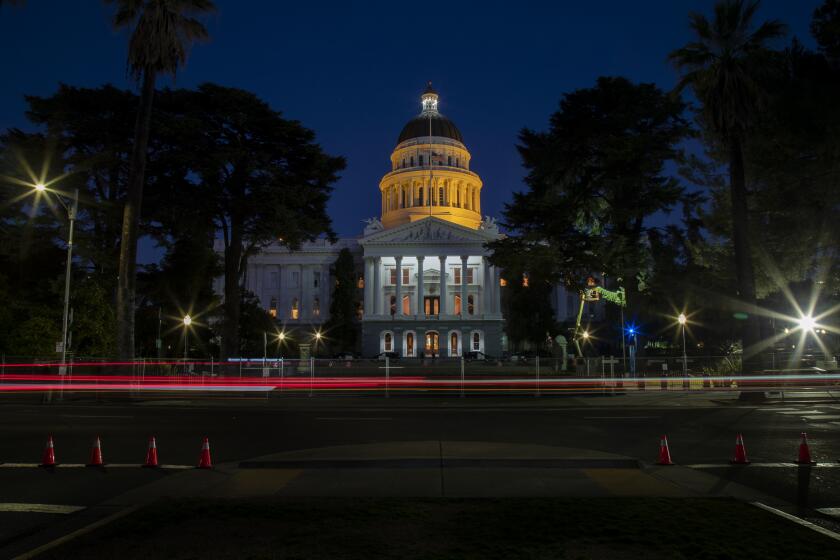Change in the Air : Face of Willowbrook Slowly Being Transformed as Redevelopment Projects, Freeway Take Root
Ever since he was a high school senior 20 years ago, Ronald Brown has heard promises of new jobs, better homes and well-stocked stores for his aging Willowbrook neighborhood.
“It gets you down,” Brown said recently, gesturing toward a dozen vacant lots that stretch for 200 yards from the 117th Street home he shares with his mother and brother.
“They tore down a lot of bad houses,” said Brown, a security guard and part-time minister, “but look what’s left. Weeds. So you have to learn to be patient, like Job, and wait.”
But change is slowly coming to Willowbrook, an amalgam of tattered apartment houses and blue-collar subdivisions that began to sprout along a trolley line 85 years ago and grew quickly after World War II, replacing the sugar beet fields between Watts and Compton.
East of Brown’s home, across the weedy lots cleared by the Los Angeles County Redevelopment Agency, blue signs at the new Kenneth Hahn Shopping Plaza are visible in the distance. To the south, an expanding medical school at the towering Martin Luther King Jr./Drew Medical Center has pushed to within a block of the Brown home. Immediately to the north is the bare earthen swath of the unfinished Century Freeway.
“It was nice here once upon a time,” Brown said, “and I guess it will be nice again. At the mall, I see young people, new people. The drug people are being pushed out. I was scared to even speak to people. Now I speak and they speak. People are coming together as a neighborhood.”
Government agencies have spent more than $100 million over the last 16 years on the hospital complex, shopping center and nearby subsidized housing, establishing a toehold amid the crime and poverty that came to define much of Willowbrook after the Watts Riots of 1965.
Despite that construction in an existing 365-acre county redevelopment zone, large patches of extraordinary decay persist. But fresh promises of change are in the air.
Recently, the Board of Supervisors, which governs the unincorporated area, authorized a study of about 1,000 acres in Willowbrook that by 1991 could be part of a new, 3,200-acre county redevelopment zone that would funnel millions of dollars more into community projects. The rest of the zone would encompass much of the Florence and Firestone areas.
County officials argue that a larger redevelopment zone--stretching three miles from Alameda Street to the Harbor Freeway--would allow them to retain tax revenue that will be generated by new businesses along the Century Freeway when it is completed in 1993. Two trolley lines that will crisscross the area and increase traffic on the Alameda railroad corridor are also expected to spur growth.
With this surge of new investment, officials say they can build upon what they call their current Willowbrook success.
It is a success that may seem paradoxical, in that one of Willowbrook’s closest neighbors is the 5,000-resident Nickerson Gardens housing project in Watts, which is notorious for its youth gangs and disrepair.
Nevertheless, change is the talk of the Willowbrook community.
Robert Kelso, unemployed since 1987 and an area resident for 30 years, said he had heard “from a guy down the street that they’re going to put a bunch of warehouses in here. I hope so. I need a job.”
Hundreds of Jobs
Jobs are already on the increase, thanks to the shopping center, the 2,700-employee hospital and the expanding medical school. County officials say they are sure that the redevelopment efforts along the new freeway will produce hundreds of jobs.
Crime is down nearly 20% from a 1981 peak, reaching 10-year lows in robbery, rape and burglary during 1987-88. The area’s 18 murders and 468 assaults last year, however, were the most in a decade, according to the Sheriff’s Department, and Willowbrook’s crime rate is still high compared to most Southeast Los Angeles County communities.
Abandoned cars once left for months are now usually removed within days because of aggressive enforcement of county zoning and health codes, community leaders say. Few transients or gang members can be found on street corners during the daytime, apparently because some of the community’s worst housing has been razed.
In addition, many residents, including a solid core of longtime homeowners and an increasing number of middle-class professionals, are pouring money into their homes.
Ted Watkins, administrator of the nonprofit Watts Labor Community Action Committee, said it has replaced decrepit housing with about 200 single-family homes and built or repaired 200 individual apartments in the Willowbrook area during the last decade.
The 140,000-square-foot Hahn shopping center is the current focus of community attention and pride. Its neighbors say it has made life easier, because they no longer have to drive for miles to buy groceries, lumber, pharmaceuticals and general merchandise.
The Willowbrook branch county library, torched by rioters 23 years ago, has also been moved into the shopping center. Book borrowing is up 25% in the year since the move, librarian Alfredo Zuniga said.
The shopping center, protected by decorative fencing and its own highly visible police force, represents the potential success of Willowbrook redevelopment but also its current limitations.
Government grants or bonds paid for 75% of the $23.8-million project. But the only restaurants the center’s developers could lure were fast-food outlets.
Jesus Arias, one of hundreds of Mexican immigrants who have moved into Willowbrook in recent years, said he bought a home there because he could find no other he could afford.
But Arias, Brown and many other residents worry that they may not be around to reap the benefits of large-scale reconstruction. They are aware that their properties can be condemned and purchased for market value by the county.
Ernest and Mary Munoz, who live across 119th Street from the shopping mall, have already been notified that their home of 46 years will be condemned.
“Oh, everything is very nice now,” Mary Munoz, 76, said. “We’ve got everything we need right here. But I hear we’ve got to move. They sent us a letter a year ago. But I hope they forgot about all that.”
County officials have not forgotten. The Munoz’s block was scheduled for redevelopment this year, but investors were not very interested in the part-retail, part-residential proposal the county had in mind, according to Jesse Lewis, a redevelopment manager. Only two proposals were submitted, he said, and neither was acceptable.
The county plans to build 100 homes on seven acres south of the shopping center and will request bids on the project this year, Lewis said. However, financing for the purchase of the acreage is “not in the bank right now,” he said.
Nor will money for other redevelopment agency projects be easy to come by because federal grants and bonds are drying up, and banks are still reluctant to lend money for inner-city projects, he said.
But the county and the city of Los Angeles, which is studying a 20-fold expansion of its nearby Watts redevelopment zone, both are counting on the expected Century Freeway boom. Taxes on all new construction in a renewal zone go to the redevelopment agency for reinvestment in the community.
More to Read
Start your day right
Sign up for Essential California for news, features and recommendations from the L.A. Times and beyond in your inbox six days a week.
You may occasionally receive promotional content from the Los Angeles Times.






